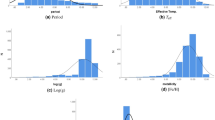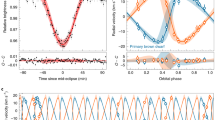Abstract
In the era of precision cosmology, it is essential to determine the Hubble constant to an accuracy of three per cent or better1,2. At present, its uncertainty is dominated by the uncertainty in the distance to the Large Magellanic Cloud (LMC), which, being our second-closest galaxy, serves as the best anchor point for the cosmic distance scale2,3. Observations of eclipsing binaries offer a unique opportunity to measure stellar parameters and distances precisely and accurately4,5. The eclipsing-binary method was previously applied to the LMC6,7, but the accuracy of the distance results was lessened by the need to model the bright, early-type systems used in those studies. Here we report determinations of the distances to eight long-period, late-type eclipsing systems in the LMC, composed of cool, giant stars. For these systems, we can accurately measure both the linear and the angular sizes of their components and avoid the most important problems related to the hot, early-type systems. The LMC distance that we derive from these systems (49.97 ± 0.19 (statistical) ± 1.11 (systematic) kiloparsecs) is accurate to 2.2 per cent and provides a firm base for a 3-per-cent determination of the Hubble constant, with prospects for improvement to 2 per cent in the future.
This is a preview of subscription content, access via your institution
Access options
Subscribe to this journal
Receive 51 print issues and online access
$199.00 per year
only $3.90 per issue
Buy this article
- Purchase on Springer Link
- Instant access to full article PDF
Prices may be subject to local taxes which are calculated during checkout




Similar content being viewed by others
References
Komatsu, E. et al. Seven-year Microwave Anisotropy Probe (WMAP) observations: cosmological interpretation. Astrophys. J. Suppl. Ser. 192, 18–65 (2011)
Freedman, W. L. & Madore, B. F. The Hubble constant. Annu. Rev. Astron. Astrophys. 48, 673–710 (2010)
Schaefer, B. E. A problem with the clustering of recent measures of the distance to the Large Magellanic Cloud. Astron. J. 135, 112–119 (2008)
Lacy, C. H. Distances to eclipsing binaries: an application of the Barnes-Evans relation. Astrophys. J. 213, 458–463 (1977)
Paczyński, B. in The Extragalactic Distance Scale (eds Livio, M., Donahue, M. & Panagia, N.) 273–280 (Space Telescope Sci. Inst. Ser., Cambridge Univ. Press, 1997)
Guinan, E. F. The distance to the Large Magellanic Cloud from the eclipsing binary HV 2274. Astrophys. J. 509, L21–L24 (1998)
Fitzpatrick, E. L., Ribas, I., Guinan, E. F., Maloney, F. P. & Claret, A. Fundamental properties and distances of Large Magellanic Cloud eclipsing binaries. IV. HV 5936. Astrophys. J. 587, 685–700 (2003)
Groenewegen, M. A. T. & Salaris, M. The LMC eclipsing binary HV 2274 revisited. Astrophys. J. 366, 752–764 (2001)
Graczyk, D. et al. The Araucaria project: an accurate distance to the late-type double-lined eclipsing binary OGLE SMC113.3 4007 in the Small Magellanic Cloud. Astrophys. J. 750, 144–156 (2012)
Udalski, A. et al. The Optical Gravitational Lensing Experiment: OGLE-III photometric maps of the Large Magellanic Cloud. Acta Astron. 58, 89–102 (2008)
Graczyk, D. et al. The Optical Gravitational Lensing Experiment: the OGLE-III catalog of variable stars. XII. Eclipsing binary stars in the Large Magellanic Cloud. Acta Astron. 61, 103–122 (2011)
Kruszewski, A. & Semeniuk, I. Nearby Hipparcos eclipsing binaries for color-surface brightness calibration. Acta Astron. 49, 561–575 (1999)
Pietrzyński, G. et al. The Araucaria project: determination of the Large Magellanic Cloud distance from late-type eclipsing binary systems. I. OGLE051019.64–685812.3. Astrophys. J. 697, 862–866 (2009)
Wilson, R. E. & Devinney, E. J. Realization of accurate close-binary light curves: application to MR Cygni. Astrophys. J. 166, 605–620 (1971)
Van Hamme, W. & Wilson, R. E. Third-body parameters from whole light and velocity curves. Astrophys. J. 661, 1129–1151 (2007)
Di Benedetto, G. P. Predicting accurate stellar angular diameters by the near-infrared surface brightness technique. Mon. Not. R. Astron. Soc. 357, 174–190 (2005)
Thompson, I. B. et al. Cluster AgeS Experiment. The age and distance of the globular cluster ω Centauri determined from observations of the eclipsing binary OGLEGC 17. Astron. J. 121, 3089–3099 (2001)
van der Marel, R. P., Alves, D. R., Hardy, E. & Suntzeff, N. B. New understanding of Large Magellanic Cloud structure, dynamics, and orbit from carbon star kinematics. Astron. J. 124, 2639–2663 (2002)
Mazzarella, J. M. NED for a new era. Astron. Soc. Pacif. Conf. 376, 153–162 (2007)
Walker, A. R. The Large Magellanic Cloud and the distance scale. Astrophys. Space Sci. 341, 43–49 (2012)
Monson, A. J. et al. The Carnegie Hubble Program: The Leavitt Law at 3.6 and 4.5 μm in the Milky Way. Astrophys. J. 759, 146–165 (2012)
Bonanos, A. Z., Castro, N., Macri, L. M. & Kudritzki, R. P. The distance to the massive eclipsing binary LMC-SC1–105 in the Large Magellanic Cloud. Astrophys. J. 729, L9–L15 (2011)
Freedman, W. L. et al. Final results from the Hubble Space Telescope key project to measure the Hubble constant. Astrophys. J. 553, 47–72 (2001)
Riess, A. G. et al. A 3% solution: determination of the Hubble constant with the Hubble Space Telescope and Wide Field Camera 3. Astrophys. J. 730, 119–137 (2011)
Benedict, G. F. et al. Hubble Space Telescope fine guidance sensor parallaxes of galactic Cepheid variable stars: period-luminosity relations. Astron. J. 133, 1810–1827 (2007)
Lutz, T. E. & Kelker, D. H. On the use of trigonometric parallaxes for the calibration of luminosity systems: theory. Publ. Astron. Soc. Pacif. 85, 573–578 (1973)
van Leeuwen, F., Feast, M. W., Whitelock, P. A. & Laney, C. D. Cepheid parallaxes and the Hubble constant. Mon. Not. R. Astron. Soc. 379, 723–737 (2007)
Pojmański, G. The All Sky Automated Survey. Acta Astron. 47, 467–481 (1997)
Acknowledgements
We acknowledge financial support for this work from the BASAL Centro de Astrofísica y Tecnologias Afines (CATA), the Polish Ministry of Science, the Foundation for Polish Science (FOCUS, TEAM), the Polish National Science Centre and the GEMINI-CONICYT fund. The OGLE project has received funding from the European Research Council ‘Advanced Grant’ Program. We thank the staff astronomers at Las Campanas and ESO La Silla, who provided expert support in data acquisition. We thank J. F. Gonzalez for making the IRAF scripts rvbina and spbina available to us. We also thank O. Szewczyk and Z. Kołaczkowski for their help with some of the observations.
Author information
Authors and Affiliations
Contributions
G.P.: photometric and spectroscopic observations and reductions. D.G.: spectroscopic observations, modelling and data analysis. W.G.: observations and data analysis. I.B.T.: observations, RV determination, data analysis. B.P.: spectroscopic observations and reductions, RV measurements. A.U., I.S. and S. K.: optical observations and data reductions. P.K., K.S., M.K., M.K.S., R.P., Ł.W., K.U., P.P., M.G. and P.K.: observations. G.B., P.G.P.M., N.N., F.B., R.P.K., J.S., A.G. and R.S.: data analysis. S.V.: analysis of the spectra. G.P. and W.G. worked jointly to draft the manuscript with all authors reviewing and contributing to its final form
Corresponding author
Ethics declarations
Competing interests
The authors declare no competing financial interests.
Supplementary information
Supplementary Information
This file contains Text and Data 1-4, Supplementary Tables 1-13, Supplementary Figure 1 and additional references. (PDF 473 kb)
Rights and permissions
About this article
Cite this article
Pietrzyński, G., Graczyk, D., Gieren, W. et al. An eclipsing-binary distance to the Large Magellanic Cloud accurate to two per cent. Nature 495, 76–79 (2013). https://doi.org/10.1038/nature11878
Received:
Accepted:
Published:
Issue Date:
DOI: https://doi.org/10.1038/nature11878
This article is cited by
-
Sub-per-cent determination of the brightness at the tip of the red giant branch in the Magellanic Clouds
Nature Astronomy (2023)
-
An extended halo around an ancient dwarf galaxy
Nature Astronomy (2021)
-
A buyer’s guide to the Hubble constant
The Astronomy and Astrophysics Review (2021)
-
The interstellar medium in young supernova remnants: key to the production of cosmic X-rays and $\gamma $-rays
Astrophysics and Space Science (2021)
-
Weighing stars from birth to death: mass determination methods across the HRD
The Astronomy and Astrophysics Review (2021)
Comments
By submitting a comment you agree to abide by our Terms and Community Guidelines. If you find something abusive or that does not comply with our terms or guidelines please flag it as inappropriate.



